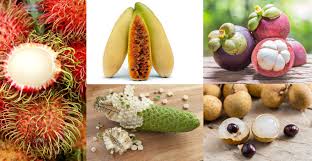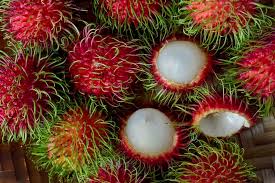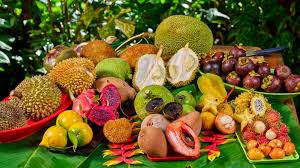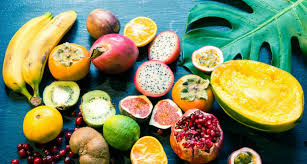
Table of Contents
- 1 What Makes a Fruit Exotic?
- 1.1 Examples of Popular Exotic Fruits
- 1.2 Nutritional Benefits of Exotic Fruits
- 1.3 Culinary Uses of Exotic Fruits
- 1.4 How to Choose and Store Exotic Fruits
- 1.5 Exotic Fruits Around the World
- 1.6 The Sustainability of Exotic Fruits
- 1.7 Incorporating Exotic Fruits into Your Lifestyle
- 1.8 Conclusion
- 1.9 About The Author
Exotic fruits are nature’s masterpieces, celebrated for their unique shapes, vibrant colors, and extraordinary flavors. These fruits often originate from tropical and subtropical regions, bringing a taste of adventure to tables around the world. From dragon fruit to rambutan, exotic fruit offer a sensory journey that excites the palate and nourishes the body.
What Makes a Fruit Exotic?

A fruit is considered exotic when it is rare or uncommon in certain parts of the world. These fruits often thrive in specific climates, making them less accessible outside their native regions. Their distinct appearances, unusual textures, and diverse flavors set them apart from the everyday fruits most people know.
Examples of Popular Exotic Fruits
The world of exotic fruits is vast, offering a variety of options to explore. Here are some of the most popular and intriguing exotic fruits:
Dragon Fruit
Also known as pitaya, dragon fruit has a striking appearance with bright pink or yellow skin and speckled flesh. Its mildly sweet flavor and crunchy seeds make it a favorite for smoothies, salads, and desserts.
Rambutan
Rambutan resembles a hairy lychee, with a soft, juicy interior and a sweet, slightly tangy flavor. Native to Southeast Asia, this fruit is enjoyed fresh or in desserts.
Mangosteen
Often called the “queen of fruits,” mangosteen has a thick purple rind and juicy white segments inside. Its flavor is a perfect balance of sweetness and acidity.
Durian
Known as the “king of fruits,” durian is infamous for its strong odor and creamy texture. While its smell divides opinion, its rich and custard-like flavor wins fans worldwide.
Starfruit
Starfruit, or carambola, is a star-shaped fruit with a tangy, slightly sweet taste. It is often used in salads, juices, or as a garnish for its eye-catching shape.
Passion Fruit
With its wrinkled skin and aromatic pulp, passion fruit adds a tropical tang to drinks, desserts, and savory dishes.
Lychee
Lychee is a small, round fruit with a rough red rind and juicy, translucent flesh. Its floral sweetness is refreshing and versatile.
Cherimoya
Often described as a custard apple, cherimoya has a creamy texture and a flavor reminiscent of bananas and pineapples.
Sapodilla
Sapodilla has a brown, rough exterior and a sweet, grainy flesh that tastes like a combination of pear and brown sugar.
Salak
Also called snake fruit due to its scaly skin, salak has a crisp texture and a sweet, tangy taste.
Nutritional Benefits of Exotic Fruits

Exotic fruits are not just intriguing in appearance and taste; they are also nutritional powerhouses. Packed with vitamins, minerals, and antioxidants, these fruits contribute to overall health and well-being.
- Rich in Vitamins and Minerals: Exotic fruit like mangosteen and lychee are high in vitamin C, boosting immunity and promoting healthy skin.
- High in Fiber: Fruits such as rambutan and passion fruit aid digestion and support gut health.
- Loaded with Antioxidants: Many exotic fruit, including dragon fruit and mangosteen, contain antioxidants that combat free radicals and reduce inflammation.
- Hydrating Properties: With high water content, fruits like starfruit and lychee help maintain hydration levels.
- Energy Boosting: The natural sugars in exotic fruit provide a quick source of energy.
Culinary Uses of Exotic Fruits
Exotic fruits are incredibly versatile and can be incorporated into a variety of dishes. Their unique flavors and textures make them ideal for both sweet and savory creations.
Smoothies and Juices
Blending exotic fruits like dragon fruit, passion fruit, and lychee creates vibrant and refreshing beverages. These drinks are perfect for hot days or as a healthy breakfast option.
Desserts
Exotic fruits are often used in desserts such as fruit tarts, ice creams, and sorbets. For example, mangosteen makes a delightful topping for cakes, while durian is used in custards and puddings.
Salads
Tossing exotic fruits like starfruit and rambutan with leafy greens and a light dressing creates a colorful and flavorful salad.
Sauces and Marinades
Fruits like passion fruit and cherimoya add a tropical twist to sauces and marinades, pairing well with seafood, chicken, and pork.
Snacks
Exotic fruits like sapodilla and salak are delicious eaten fresh, providing a natural and healthy snack.
How to Choose and Store Exotic Fruits
Selecting and storing exotic fruits properly ensures the best flavor and texture. Here are some tips:
- Look for Ripeness: Exotic fruits often have specific signs of ripeness. For instance, a ripe mangosteen should have a slightly soft skin, while a ripe starfruit should be golden-yellow.
- Handle with Care: Many exotic fruits have delicate skins or soft interiors, so handle them gently to avoid bruising.
- Store Appropriately: Some fruits, like durian and mangosteen, should be consumed shortly after purchase, while others, like passion fruit, can be stored in the refrigerator for a few days.
Exotic Fruits Around the World

Exotic fruits have deep cultural significance in their togelon regions of origin. They are often used in traditional dishes, religious rituals, and celebrations.
Southeast Asia
Southeast Asia is home to fruits like durian, rambutan, and mangosteen. These fruits are staples in local markets and are often enjoyed fresh or incorporated into regional dishes.
Latin America
Latin America offers fruits such as cherimoya, sapodilla, and passion fruit. These fruits are widely used in drinks like agua fresca and desserts like flan.
Africa
In Africa, exotic fruits like baobab and marula are cherished for their nutritional value and unique flavors. They are often used in juices, jams, and traditional medicines.
The Caribbean
The Caribbean boasts fruits like guava, soursop, and ackee. These fruits are integral to the region’s cuisine, adding tropical flavors to dishes and beverages.
The Sustainability of Exotic Fruits
As demand for exotic fruits grows, it is important to consider their environmental impact. Supporting local farmers and choosing fruits that are sustainably sourced can help reduce the carbon footprint associated with transporting exotic fruits globally.
Incorporating Exotic Fruits into Your Lifestyle
Adding exotic fruits to your diet is a delicious way to expand your culinary horizons. Experiment with new fruits, learn about their origins, and explore creative ways to enjoy them. From morning smoothies to elegant desserts, exotic fruits can elevate any meal.
Conclusion
Exotic fruits are a testament to the diversity and beauty of nature. Their unique flavors, vibrant colors, and nutritional benefits make them a delightful addition to any diet. Whether you’re exploring the juicy sweetness of a lychee, the tangy zest of a passion fruit, or the creamy richness of a cherimoya, exotic fruits offer a world of flavors waiting to be discovered. Embrace these treasures and let them bring a touch of adventure and nourishment to your plate.








